One of the greatest aspects of Sudoku is that the game offers engaging challenges to both the novice, as well as the seasoned puzzle player. Whenever they play a puzzle tailored for their level of competence, both the beginner and the experienced Sudoku solver will have to put a good amount of thought and technique into completing the task. Their approach, though, may not be the same. Solving a hard Sudoku puzzle will require quite a different set of techniques compared to an easy one. This article presents nine such techniques; in increasing difficulty.
When utilizing these techniques, the way the pros prefer to do it, is to start with the basic ones. Use the first few techniques to insert as many numbers as you can. Then, when you can add no more numbers to the board using the basic techniques, try the more advanced ones. Do one at a time until you can plot one more number into a cell. Then, start with the basic techniques again, and repeat the process. You should be able to solve almost any Sudoku puzzle using these techniques.
Techniques for removing numbers:
Sole Candidate
When a specific cell can only contain a single number, that number is a "sole candidate". This happens whenever all other numbers but the candidate number exists in either the current block, column or row.
In this example, the red cell can only contain the number 5, as the other eight numbers have all been used in the related block, column and row.
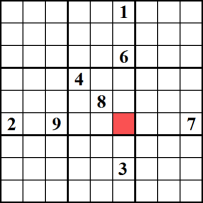
Unique Candidate
You know that each block, row and column on a Sudoku board must contain every number between 1 and 9. Therefore, if a number, say 4, can only be put in a single cell within a block/column/row, then that number is guaranteed to fit there. This example illustrates the number 4 as the unique candidate for the cell marked in red.
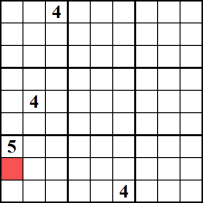
Techniques for removing candidates:
Block and column / Row Interaction
This method won't help you pencil in any new numbers, but it will help you nail a number down within a specific row or column. The example shows that the number 7 can only be inserted in the red cells of the middle row. Thus you can remove 7 as a possible candidate from the rest of the row.
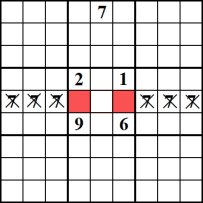
Block / Block Interaction
This technique is best understood by looking at the example. In the middle and the middle-left blocks, the number 8 must be placed in one of the red cells. This means, we can eliminate 8 from the upper and lower rows in the middle-right column.
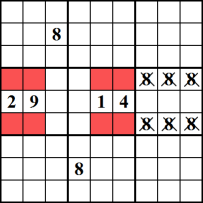
Naked Subset
The example shows that row number 1 and row number 5 both have a cell in the same column containing only the candidate numbers 4 and 7. These two numbers appear as candidates in all of the other open cells in that column too, but since they are the only two candidates in rows 1 and 5, these two numbers cannot appear anywhere else in the row, thus you can remove them. In the example, the two candidate pairs circled in red, are the sole candidates. Since 4 and 7 must be placed in either of these two cells, all of the pairs circled in blue, can remove those numbers as candidates. In this puzzle, this means 1 becomes sole candidate in the second row; 2 becomes sole candidate in row 6; and thus, 6 is sole candidate for row number 4.
You can also use this technique if you have more than two candidates. For example, let us say the pairs circled in red were instead triple candidates of the numbers 1, 4, 7. This would mean those three numbers would have to be placed in either rows 1, 2 or 5. We could remove these three numbers as candidates in any of the remaining cells in the column. This technique even works with four candidate numbers, assuming you have 4 possible candidates in four different cells in a row/column.
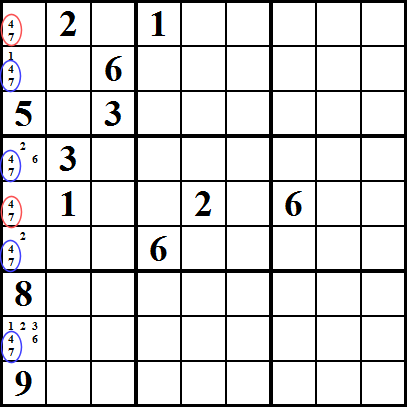
Hidden subset
This is similar to Naked subset, but it affects the cells holding the candidates. In this example, we see that the numbers 5, 6, 7 can only be placed in cells 5 or 6 in the first column (marked in a red circle), and that the number 5 can only be inserted in cell number 8 (marked in a blue circle). Since 6 and 7 must be placed in one of the cells with a red circle, it follows that the number 5 has to be placed in cell number 8, and thus we can remove any other candidates from the 8th cell; in this case, 2 and 3.
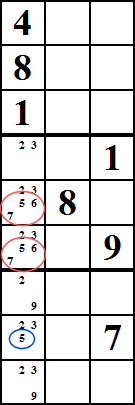
X-Wing
This method can work when you look at cells comprising a rectangle, such as the cells marked in red. In this example, let's say that the red and blue cells all have the number 5 as candidate numbers. Now, imagine if the red cells are the only cells in column 2 and 8 in which you can put 5.
In this case you obviously need to put a 5 in two of the red cells, and you also know they cannot both be in the same row. Well, now, this means you can eliminate 5 as the candidate for all the blue cells. This is because in the top row, either the first or the second red cell must have a 5, and the same can be said about the lower row.
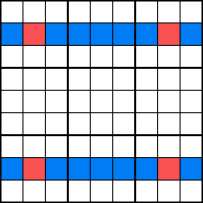
Swordfish
Swordfish is a more complicated version of X-Wing. In most cases, the technique might seem like much work for very little pay, but some puzzles can only be solved with it. So if you want to be a sudoku-solving master, read on!
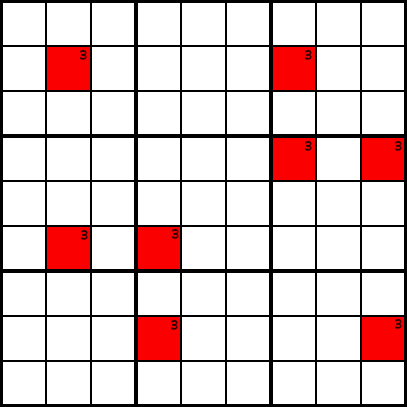 Example A
Example A
In example A, we've plotted in some candidate cells for the number 3. Now, assume that in column 2, 4, 7 and 9, the only cells that can contain the number 3 are the ones marked in red. You know that each column must contain a 3.
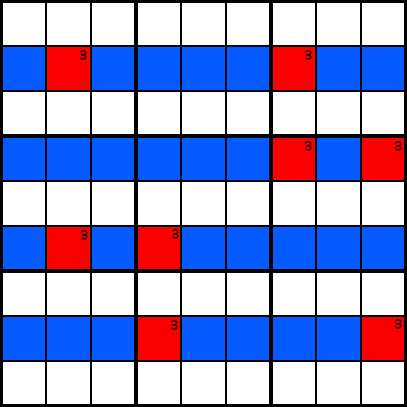 Example B
Example B
Look at example B. We can eliminate 3 as candidate in every cell marked in blue. The reason for this is that if we consider the possible placements of the number 3 in the red cells, we get two alternatives: either you must put 3s in the green cells, or in the purple cells, as example C shows. In any case, each of the columns 2, 4, 7 and 9, must contain a 3 in one of the colored cells, so no other cell in those rows can contain a 3.
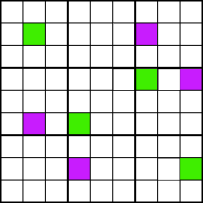 Example C
Example C
How do you recognize a swordfish pattern? You look for cells with common candidate numbers that can be chained together like in example D. If you start on, say, the top-left red cell. Then you draw a line either vertically or horizontally until you reach another cell containing the same candidate number. Then you repeat this pattern until you return to the original cell. If you reach the original cell, you have a swordfish pattern!
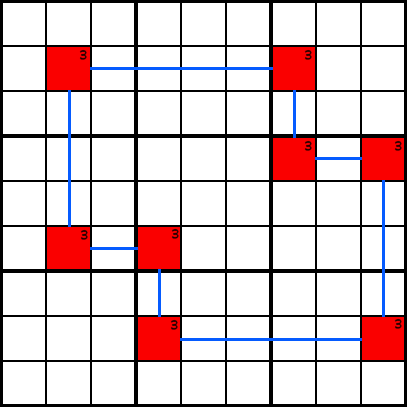 Example D
Example D
Forcing Chain
Forcing chain can actually help you determine exactly what number a certain cell must hold. Unfortunately, the technique is not the easiest to utilize. Look at the example below. Let us assume that the candidates in the red cells are the sole candidates for those cells.
Forcing chains work in the following way: Start on the red cell with the arrow pointing towards it, and fill in one of the two candidates, 3 or 6, for that cell. Then follow on and fill in the rest of the red cells. Now take a note of the values you enter along the way. Go back to the cell you started with and try the other candidate number for that cell, and fill in the other red cells as well. Compare the numbers you got now with the first result. You may find that in both cases, a certain cell must contain a specific number.
In this example, if you put the number 3 in the starting cell, you will see that the above-right neighboring cell must contain a 9. Now, try and enter a 6 in the starting cell instead, and move the other way around, entering candidate values. When you reach the above-right neighboring cell again, you will find it must contain a 9 this time around too. Thus this cell must contain a 9.
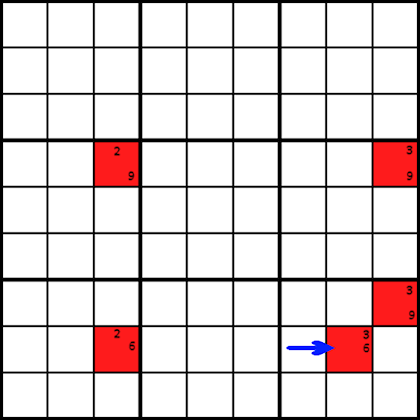
That's it. Hope this will help you crack even the toughest sudoku puzzles out there. Good luck!
This article is a part of our
Sudoku Help section.
Play Sudoku Epic
Sudoku Epic is a free, premium quality Sudoku game and is available on most platforms: PC, Mac, iPhone, iPad, Android, Google Play Store and Amazon Appstore.
Get it!
 Sudoku Epic
Sudoku Epic on Google Play
Sudoku Epic on iPhone/iPad







 Example A
Example A Example B
Example B Example C
Example C Example D
Example D